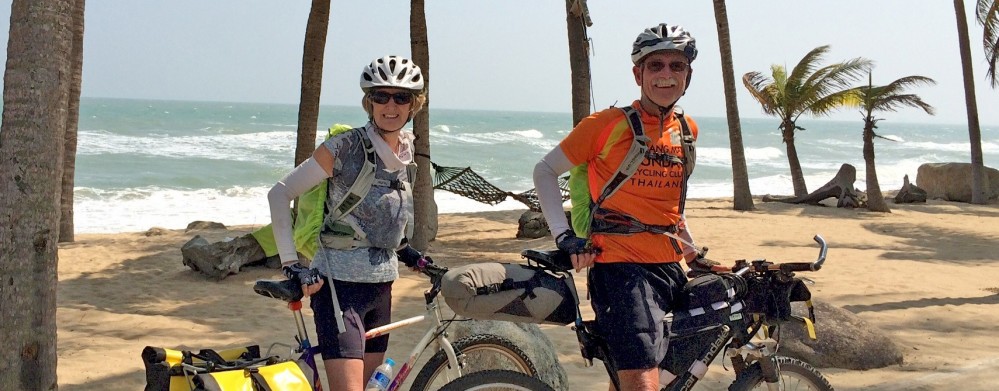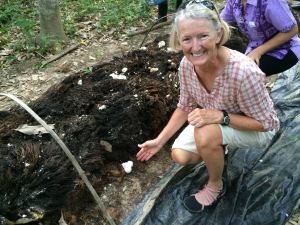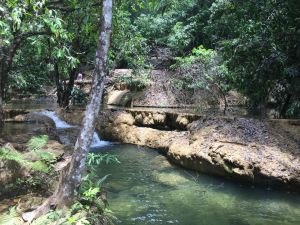 Three times now, I’ve been part of the Pot-top presentation to the Haui Yot Hospital about 25 miles north of Trang. The Trang Cycling Club collects pop-tops over time, off their own beverage consumption, from roadside trash, and who knows where. Maybe once a year (I’ve been three different years) they cycle as a group to present the aluminum to the doctor director of the hospital in typical Thai fashion: a speech from
Three times now, I’ve been part of the Pot-top presentation to the Haui Yot Hospital about 25 miles north of Trang. The Trang Cycling Club collects pop-tops over time, off their own beverage consumption, from roadside trash, and who knows where. Maybe once a year (I’ve been three different years) they cycle as a group to present the aluminum to the doctor director of the hospital in typical Thai fashion: a speech from  both parties and hundreds of photo shots. On this occasion 25-plus cyclists pedaled the 45-km ride with their saddle bags and handlebars loaded with pop-tops. (The club and their various factions and splinter groups is said to be more than 350 and growing rapidly.) So we don’t know just how many locals collect pop-tops, but it’s a dedicated group, in any case, to aggregate more than 30 pounds of those little clips.
both parties and hundreds of photo shots. On this occasion 25-plus cyclists pedaled the 45-km ride with their saddle bags and handlebars loaded with pop-tops. (The club and their various factions and splinter groups is said to be more than 350 and growing rapidly.) So we don’t know just how many locals collect pop-tops, but it’s a dedicated group, in any case, to aggregate more than 30 pounds of those little clips.
 As the blog title says, these pop-tops go to helping amputees. This quality of aluminum is evidently best for forming prosthetic limbs and the Haui Yot Hospital works directly with converting this resource into helping the disabled. Our presentation day was timed to coincide with a “eat and be healthy fair” in the hospital parking lot. So we were pressed forward to the ever-present popup bandstand, with its rock concert speaker setup, and greeted at full volume, to the curious crowd sampling 6 kinds of blended fruit and vegetable smoothies, health remedies and fitness promotions. (The four blends I sampled must have been responsible for the faster pace I experience on the homeward ride.)
As the blog title says, these pop-tops go to helping amputees. This quality of aluminum is evidently best for forming prosthetic limbs and the Haui Yot Hospital works directly with converting this resource into helping the disabled. Our presentation day was timed to coincide with a “eat and be healthy fair” in the hospital parking lot. So we were pressed forward to the ever-present popup bandstand, with its rock concert speaker setup, and greeted at full volume, to the curious crowd sampling 6 kinds of blended fruit and vegetable smoothies, health remedies and fitness promotions. (The four blends I sampled must have been responsible for the faster pace I experience on the homeward ride.)
 Of course Thai ceremonies, fairs and festivals always include entertainment, hence the bandstands (which BTW you see daily traveling the highways, speakers bulging off the back of pickups). We missed these dancers’ performance, but they were being interviewed as we arrived. It isn’t polite to comment on their “style”. Surely a historic tradition of a bygone time.
Of course Thai ceremonies, fairs and festivals always include entertainment, hence the bandstands (which BTW you see daily traveling the highways, speakers bulging off the back of pickups). We missed these dancers’ performance, but they were being interviewed as we arrived. It isn’t polite to comment on their “style”. Surely a historic tradition of a bygone time.

 For those of us wanting a little longer ride, culture or tour, half of us ventured farther north to a Karst limestone cave whose many chambers and caverns proffered its Buddhist statuary and tributes.
For those of us wanting a little longer ride, culture or tour, half of us ventured farther north to a Karst limestone cave whose many chambers and caverns proffered its Buddhist statuary and tributes.
Just another weekend club ride. Next week we’re going further north to the island Koh LIbong for their festival.
[Here is a link to the Malaspina University Geology website with a graphic that explains how Karst’s are formed]

 With only a day’s rest, and jet lag recovery still needed, the next invitation to ride came that evening saying there was an opportunity to ride with a Bangkok representative of the Thai Office of Tourism, who wanted to see all the sights around Trang in order to promote cycling in this region.
With only a day’s rest, and jet lag recovery still needed, the next invitation to ride came that evening saying there was an opportunity to ride with a Bangkok representative of the Thai Office of Tourism, who wanted to see all the sights around Trang in order to promote cycling in this region.

























 added a bonus to their rubber tree groves by raising mushrooms in rows between the trees. The mushrooms can be picked daily.
added a bonus to their rubber tree groves by raising mushrooms in rows between the trees. The mushrooms can be picked daily.








 leaves, sliced red chilies and chicken. This was more of a soup boiling in the wok and we couldn’t imagine what would happen to turn this into a succulent sauce with chicken.
leaves, sliced red chilies and chicken. This was more of a soup boiling in the wok and we couldn’t imagine what would happen to turn this into a succulent sauce with chicken.






 And her preference was three times the amount of Thai basil which Sunsern extracted so a comparison might be more fair. Again, the secret to the sauce was boiling down the mixture to a thick viscous liquid before turning off the flame.
And her preference was three times the amount of Thai basil which Sunsern extracted so a comparison might be more fair. Again, the secret to the sauce was boiling down the mixture to a thick viscous liquid before turning off the flame.



































